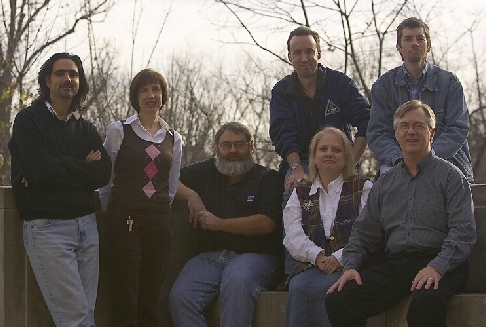

Mission Status Report #79 Star Date: December 9, 2004
FUSE Completes Five Years of Science Operations!Caption: The FUSE Mission Planning Team. (Left to right) Humberto Calvani, Alice Berman (Chief of Mission Planning), Martin England, Julia Andersen, and Bill Blair (Chief of Observtory Operations). Back row: Bryce Roberts and Jim Caplinger. (Photo courtesy of Bryce Roberts and MaryBeth Kaiser, JHU.)
Operations on the FUSE satellite continue to proceed nominally since my last report. (I love reports that start this way!) Operations continue at this point using a single gyro in the control loop. With two and a half months of one-gyro operations under our belts, all is operating smoothly and as expected. (One-gyro operations are currently being used due to a noisy gyro that developed during the June-Sept. 2004 period. See this previous report.) The FUSE project reached a significant milestone on December 1, 2004, with the completion of five full years of science operations! Interestingly, we were also executing Mission Planning Schedule #500 at the time. Mission Planning Schedules, or MPSs as we call them, are the detailed timeline plans that are constructed by the Mission Planning Team and delivered to the control center for translation into "spacecraft" language and then uplinked to the satellite. Early in the mission, MPSs were delivered every couple of days, but we have now settled into a routine where we can plan farther ahead and in bigger chunks. A typical MPS now covers about a week, with the occasional special activity requiring an extra delivery from time to time. Creating these schedules is definitely not a push-button operation. The software that generates the MPSs and performs all kinds of consistency checks has risen in complexity with time, and this software is a key element in FUSE operations. However, there is still a "creative" aspect to every MPS that involves a delicate balancing of many competing components, such as target priorities, downstream target availabilities for the targets under consideration, guide star availabilities, and optical channel alignment issues. It is hard to quantify the extra benefit that is obtained through this careful process, but every observation made with FUSE is carefully crafted into its place in the timeline to provide the quality science data that have become our hallmark. The creative technical staff that performs this important function is shown in the photograph above. (They asked me to sit in since I started out as the head of the mission planning group for FUSE before I became Chief of Observatory Operations.) This photo was taken December 2, 2004, shortly after we held a celebratory luncheon in honor of MPS 500 and the excellent work of the MP team over all these years. To date nearly 51 MILLION seconds of science observations have been garnered with the FUSE satellite. Now that's something to be proud of! The deadline for Cycle 6 FUSE proposals was Sept. 17, 2004. NASA received a record number of new proposals for potential observation in Cycle 6, for a record amount of requested time. Competition was stiff, but we take this as a good sign that the astronomical community still holds a keen interest in new FUSE observations! Proposal recommendations were made by a Peer Review in mid-November, and NASA will announce results in early January 2005. Good luck to all who proposed. Finally, on behalf of the FUSE project, let me wish you all a Happy Holidays and best wishes for a wonderful 2005! Reported by: Bill Blair, FUSE Chief of Observatory Operations
|
